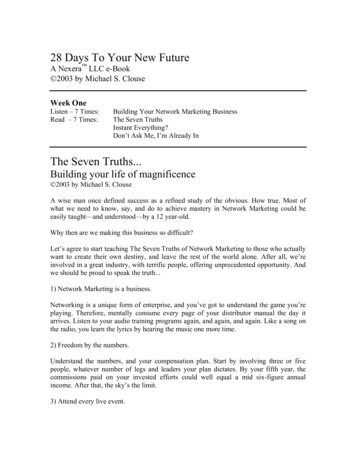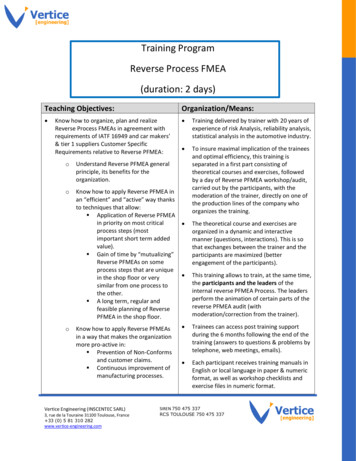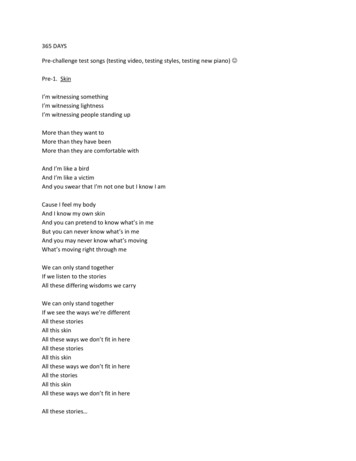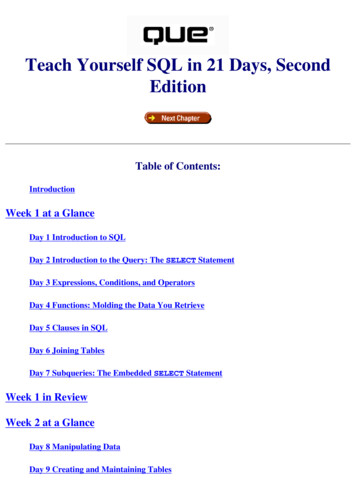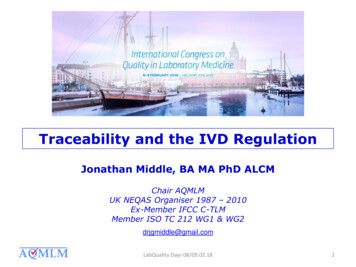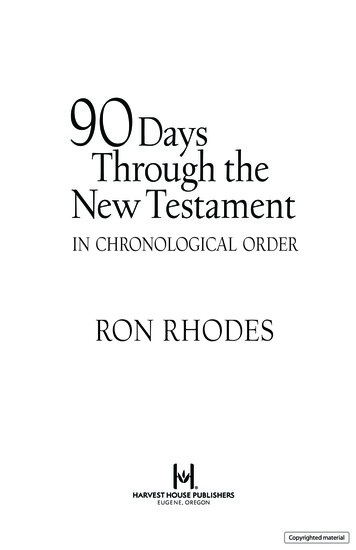
Transcription
Copyrighted material
Unless otherwise indicated, all Scripture quotations are from The ESV Bible (The Holy Bible, English Standard Version ), copyright 2001 by Crossway, a publishing ministry of Good News Publishers. Used by permission. All rights reserved.Verses marked niv are taken from the Holy Bible, New International Version , NIV . Copyright 1973, 1978, 1984, 2011 by Biblica, Inc. Used by permission. All rights reserved worldwide.Verses marked nasb are taken from the New American Standard Bible , 1960, 1962, 1963, 1968,1971, 1972, 1973, 1975, 1977, 1995 by The Lockman Foundation. Used by permission. (www.Lockman.org)Cover by Dugan Design Group, Bloomington, MinnesotaCover photos AnnekaS / Bigstock; Volodymyr Horbovyy / Shutterstock90 DAYS THROUGH THE NEW TESTAMENTIN CHRONOLOGICAL ORDERCopyright 2015 Ron RhodesPublished by Harvest House PublishersEugene, Oregon 97402www.harvesthousepublishers.comLibrary of Congress Cataloging-in-Publication DataRhodes, Ron.90 days through the New Testament in chronological order / Ron Rhodes.pages cmIncludes bibliographical references.ISBN 978-0-7369-6431-9 (pbk.)ISBN 978-0-7369-6432-6 (eBook)1. Bible. New Testament—Criticism, interpretation, etc. I. Title. II. Title: Ninety days throughthe New Testament in chronological order.BS2361.3.R49 2015225.6—dc232015000617All rights reserved. No part of this publication may be reproduced, stored in a retrieval system, ortransmitted in any form or by any means—electronic, mechanical, digital, photocopy, recording,or any other—except for brief quotations in printed reviews, without the prior permission of thepublisher.Printed in the United States of America15 16 17 18 19 20 21 22 23 / BP-JH / 10 9 8 7 6 5 4 3 2 1Copyrighted material
To Kerri, David, and KylieCopyrighted material
AcknowledgmentsKerri, David, and Kylie—The sun seems to shine brighter with you in my world!What an awesome family the Lord has given us.All my friends at Harvest House Publishers—Your collective efforts have spiritually enriched multitudesaround the globe.I feel privileged to work with you!Copyrighted material
ContentsIntroduction . . . . . . . . . . . . . . . . . . . . . . . . . . . . . . . . .71. Jesus’s Incarnation and Early Ministry. . . . . . . . . . . . . . 192. Jesus’s Ministry in Galilee, Perea, and Judea. . . . . . . . . . 313. Passion Week. . . . . . . . . . . . . . . . . . . . . . . . . . . . . . . . . 1414. The Church Is Born and the Gospel Spreads . . . . . . . . . 2055. Paul’s Second and Third Missionary Tours. . . . . . . . . . . 2336. Paul in Prison. . . . . . . . . . . . . . . . . . . . . . . . . . . . . . . . . 2917. The Final Letters and Future Hope. . . . . . . . . . . . . . . . . 337Postscript: Jesus—the Heart of the New Testament. . . . 387Bibliography . . . . . . . . . . . . . . . . . . . . . . . . . . . . . . . . . 391Notes. . . . . . . . . . . . . . . . . . . . . . . . . . . . . . . . . . . . . . . 392Daily Reading Index . . . . . . . . . . . . . . . . . . . . . . . . . . . 393Copyrighted material
Copyrighted material
IntroductionThank you for joining me on this exciting journey through the NewTestament. You are in for a spiritually uplifting time! My hope andprayer is that as you read 90 Days Through the New Testament in Chronological Order, you will experience a growing love for the Word of God, grow in your knowledge of and appreciation for the wondroussalvation you have in Jesus Christ, experience more daily intimacy with Jesus than ever before, understand and experience God’s incredible grace in yourdaily walk with Him, grow in your knowledge of the Holy Spirit and dependenceon Him as He empowers you to live the Christian life, grow in your faith and trust in God in the midst of life’s troubles, and gain an eternal perspective so that you see life’s problems anddifficulties from heaven’s vantage point.As we begin our journey together, I want to address a few thingsthat will lay a foundation for better understanding the New Testament.Let’s look at the big picture first and consider some preliminary mattersabout how this book is arranged. Then we will zero in on our chronological study of the New Testament.7Copyrighted material
890 Days Through the New Testament in Chronological OrderThe Significance of the New TestamentThe New Testament is a collection of 27 writings composed over a50-year period by nine different authors from various walks of life. Theprimary personality of the New Testament is Jesus Christ. The primarytheme is salvation in Jesus Christ, based on the new covenant.The word “testament” refers to a covenant or agreement. The OldTestament focuses on an old covenant between God and the Israelites.According to that covenant (the Sinai covenant), the Jews were to beGod’s people and render obedience to Him, and in return God wouldbless them (Exodus 19:3-25). Israel failed repeatedly and continuallyviolated this covenant. So even in Old Testament times, the prophets began to speak of a new covenant that would focus not on keepingexternal laws but on an inner reality and change in the human heart( Jeremiah 31:31). Unlike the Sinai covenant, the new covenant was tomake full provision for the forgiveness of sins.When Jesus ate the Passover meal with the disciples in the upperroom, He spoke of the cup as “the new covenant in my blood” (Luke22:20; see also 1 Corinthians 11:25). Hebrews 7 demonstrates thatChrist’s priesthood is superior to the old priesthood, and it logicallyfollows that such a superior priesthood would have a superior ministry.Such a ministry is provided for in the new covenant. Jesus has done allthat is necessary for the forgiveness of sins by His once-for-all sacrificeon the cross. This new covenant is the basis for our relationship withGod in the New Testament.The Books of the New TestamentThe first four books of the New Testament are the Gospels: Matthew, Mark, Luke, and John. Each of these contains an account ofthe life of Christ. None portrays all the details of His life, but takentogether, they provide a full composite account.Each Gospel author included different details, depending on hispurpose for writing. For example, the Gospel of Matthew has morecitations from the Old Testament than any other Gospel because Matthew sought to prove to the Jews that Jesus is the Messiah prophesied inthe Old Testament. Mark, by contrast, had no such Jewish motivation,Copyrighted material
Introduction9but instead sought to portray Jesus in action rather than as a teacher.Luke’s Gospel stresses the wonderful blessings of salvation for all people.John’s Gospel focuses heavily on the identity of Jesus and thoroughlydemonstrates His deity.Following the Gospels is the book of Acts, which traces the spreadof Christianity following the death and resurrection of Christ. Thoughthe book is traditionally understood as the acts of the apostles, it isprobably more appropriately understood as the acts of the Holy Spirit,for truly it is the Holy Spirit who seems to be active in just about everychapter of the book.Following the book of Acts are the epistles, or letters. The apostlePaul wrote 13 of these, and the rest were written by other followers ofJesus. Many of the New Testament epistles were written to brand-newchurches that had certain issues that needed to be addressed (1 and2 Thessalonians are examples). The apostle Paul often wrote letters tofollow up his missionary visits to churches. (For example, Paul wroteEphesians following his visit to the church at Ephesus.) Therefore,Paul’s letters are often personal. In some cases, Paul gave advice tothe leader of a particular church. (Such was the case when Paul wrote1 Timothy.) Other times he addressed the church as a whole. (Philippians is a good example.)Other New Testament epistles—the “general epistles”—werenot directed at specific churches, but were circulated to a number ofchurches and dealt with general concerns. These are primarily the nonPauline epistles, such as James; 1 and 2 Peter; and 1, 2, and 3 John.Though the epistles were originally written for first-century Christians, they have tremendous relevance for Christians today. Indeed,the issues dealt with in the epistles are relevant to every generation. Weneed spiritual instruction just as the ancients did.The final book of the New Testament is the book of Revelation,which is an apocalyptic book full of prophecy. This book was writtento persecuted believers to give them hope, inspiration, and comfort sothey could patiently endure the struggles they were facing. The bookdemonstrates that God wins in the end and that we will all live faceto-face with Him forever in new heavens and a new earth. The bookCopyrighted material
1090 Days Through the New Testament in Chronological Orderalso gives strong hope to current-day Christians who live in an increasingly troubled world.The Inspiration of the New Testament BooksThe biblical Greek word translated “inspired” literally means “Godbreathed.” Biblical inspiration may be defined as God’s superintendingof the human authors so that, using their own individual personalitiesand writing styles, they composed and recorded without error His revelation to humankind in the words of the original autographs (handwritten manuscripts). In other words, the original documents of theBible were written by men who, though permitted to exercise their ownpersonalities and literary talents, wrote under the control and guidanceof the Holy Spirit, the result being a perfect and errorless recording ofthe exact message God desired to give to man.The writers of Scripture were thus not mere writing machines. Goddid not use them like keys on a typewriter to mechanically reproduceHis message. Nor did He dictate the words, page by page. The biblicalevidence shows that each writer had a style of his own. Matthew’s writing had Jewish overtones, Mark’s writing was action-oriented, Luke’sstyle had medical overtones, John was very simple in his approach, andPaul had a theological style. The Holy Spirit infallibly worked througheach of these writers, through their individual styles, to communicateHis message without error to humankind. This means that you cantrust your New Testament (and, of course, the Old Testament as well).The New Testament CanonThe word “canon” comes from a Greek word that means “measuring stick.” Over time, the word eventually came to be used metaphorically of books that were “measured” and thereby recognized as beingGod’s Word. When we talk about the canon of Scripture today, weare referring to all the biblical books that collectively constitute God’sWord.Many books written during New Testament times were recognized as being the Word of God at that time. In 1 Timothy 5:18, forexample, the apostle Paul joined an Old Testament reference and aCopyrighted material
Introduction11New Testament reference and called them both (collectively) Scripture(Deuteronomy 25:4 and Luke 10:7). It would not have been unusualin the context of first-century Judaism for an Old Testament passageto be called Scripture. But for a New Testament book to be referred toas Scripture so soon after it was written says volumes about Paul’s viewof the authority of contemporary New Testament books.Only three years elapsed between the writing of the Gospel of Lukeand the writing of 1 Timothy. (Luke was written around AD 60, and1 Timothy was written around AD 63.) Despite this, Paul—himself aJew, a “Hebrew of Hebrews”—does not hesitate to place Luke on thesame level of authority as the Old Testament book of Deuteronomy.Further, the writings of the apostle Paul were recognized as Scripture by the apostle Peter (see 2 Peter 3:16). Paul, too, understood thathis own writings were inspired by God and therefore authoritative(1 Corinthians 14:37; 1 Thessalonians 2:13). Paul, of course, wroteabout half the New Testament books.When the church formally recognized which books belonged inthe canon at the Council of Carthage in AD 397, five primary testswere applied.Was the book written or backed by a prophet or apostle of God? The reasoning here is that the Word of God which is inspired by the Spirit ofGod for the people of God must be communicated through a man ofGod. Second Peter 1:20-21 assures us that Scripture is written only bymen of God. In Galatians 1:1-24 the apostle Paul argued for support ofthe letter he was writing by appealing to the fact that he was an authorized messenger of God, an apostle.Is the book authoritative? In other words, can it be said of this bookas it was said of Jesus, “The people were amazed at his teaching, becausehe taught them as one who had authority, not as the teachers of thelaw” (Mark 1:22)? Put another way, does this book ring with a sense of“Thus saith the Lord”?Does the book tell the truth about God as it has already been revealed?The Bereans searched the Old Testament Scriptures to see whetherPaul’s teaching was true (Acts 17:11). They knew that if Paul’s teachingdid not accord with the Old Testament canon, it could not be of God.Copyrighted material
1290 Days Through the New Testament in Chronological OrderAgreement with all earlier revelation is essential. Paul certainly recognized this, for he said to the Galatians, “Even if we or an angel fromheaven should preach to you a gospel contrary to the one we preachedto you, let him be accursed” (Galatians 1:8).Does the book give evidence of having the power of God? The reasoninghere is that any writing that does not exhibit the transforming power ofGod in the lives of its readers could not have come from God. Scripturesays that the Word of God is living and active (Hebrews 4:12). SecondTimothy 3:15-17 indicates that God’s Word has a transforming effect.If the book in question did not have the power to change lives, thenthe book could not have come from God.Was the book accepted by the people of God? In the New Testament,Paul thanked the Thessalonians for receiving his message as the Wordof God (1 Thessalonians 2:13). Paul’s letters were circulated among thechurches (Colossians 4:16; 1 Thessalonians 5:27). It is the norm thatGod’s people—that is, the majority of them and not simply a faction—will initially receive God’s Word as such.Interestingly, in AD 367—some 30 years prior to the Councilof Carthage—Athanasius (a bishop of Alexandria and a great champion of orthodoxy) wrote his Paschal Letter, in which he listed all thebooks of our present New Testament canon. So even before this definitive council met, the books that belonged in the New Testament werealready known.The bottom line is this: You can trust that the New Testament booksare truly the Word of God.The Reliability of the New TestamentThe New Testament is not based on myth or hearsay. Rather, it isbased on eyewitness testimony. John, who wrote the Gospel of John,said in his first epistle, “That which was from the beginning, which wehave heard, which we have seen with our eyes, which we looked uponand have touched with our hands, concerning the word of life weproclaim also to you” (1 John 1:1-3). Peter likewise wrote, “We did notfollow cleverly devised myths when we made known to you the powerCopyrighted material
Introduction13and coming of our Lord Jesus Christ, but we were eyewitnesses of hismajesty” (2 Peter 1:16).The Bible writers gave up their lives defending what they wrote.No one gives up his or her life in defense of a lie! Further, manuscriptevidence and archeological discoveries give a convincing stamp ofapproval to the reliability of the New Testament.The Authority of the New TestamentScripture alone is the supreme and infallible authority for thechurch and the individual believer (1 Corinthians 2:13; 1 Thessalonians2:13; 2 Timothy 3:16-17; 2 Peter 1:21). Certainly Jesus and the apostles often gave testimony to the absolute authority of the Bible as theWord of God. Jesus affirmed the Bible’s divine inspiration (Matthew22:43), its indestructibility (Matthew 5:17-18), its infallibility ( John10:35), its final authority (Matthew 4:4,7,10), its historicity (Matthew12:40; 24:37), and its factual inerrancy (Matthew 22:29; John 17:17).Scripture has final authority because it is a direct revelation fromGod and carries the very authority of God Himself (Galatians 1:12).What the Bible says, God says. The Scriptures are the final court ofappeal on all doctrinal and moral matters. We need no other source,and indeed no other source is authoritative and binding upon theChristian.Jesus said, “Scripture cannot be broken” ( John 10:35). He also said,“Until heaven and earth pass away, not an iota, not a dot, will pass fromthe Law until all is accomplished” (Matthew 5:18). He said, “It is easierfor heaven and earth to pass away than for one dot of the Law to becomevoid” (Luke 16:17). Jesus appealed to Scripture in every disputed matter. To the Sadducees He said, “You are wrong, because you know neither the Scriptures nor the power of God” (Matthew 22:29). He toldsome Pharisees that they invalidated the Word of God by their traditionthat had been handed down (Mark 7:13). To the devil, Jesus consistentlyresponded, “It is written ” (Matthew 4:4-10). Following Jesus’s lead, wemust conclude that Scripture alone is our supreme and final authority.This means that as we read the New Testament, we are not toCopyrighted material
1490 Days Through the New Testament in Chronological Orderconsider it as merely the words of men. Let’s recognize it for what itis—the very Word of God, which has authority over our lives.The Challenges of a Chronological ApproachThere are some definite challenges to taking a chronologicalapproach to studying the New Testament. The foremost is that biblical scholars differ on the exact chronological order of events. This pointhas been recognized by all the chronological study Bibles in print. TheChronological Life Application Study Bible states, “Organizing the Bibleinto chronological order is sometimes tricky, and excellent Christianscholars do not always agree on the order of certain books or passages.” 1The Chronological Study Bible: NIV likewise affirms, “Rearranging theBible is a fallible human effort. Even those who have earned advanceddegrees in the various fields of biblical studies would disagree on anyparticular rearrangement.” 2 The Chronological Study Bible: New KingJames Version adds, “Rearranging the biblical books chronologically isby no means easily accomplished, since Bible scholars differ on almostevery important point of chronology.” 3 That means no biblical chronology—including the one suggested in this book—should be considered inspired or inerrant, as is the Word of God.As I wrestled through the New Testament chronology, I discoveredthat chronological problems surface most in the four Gospels. To befair, none of the Gospel writers set out to write a precise chronology ofthe teachings and events in the life of Christ. They could have done this,but that wasn’t their purpose. Each of the writers had a unique purposein writing his Gospel, and the varied purposes account for many of thedifferences in chronology.There has also been significant debate over the varying details contained in the Gospel accounts. But I believe there are viable reasons forthese differences. Foundationally, we know from human experiencethat different people will notice different things about the same event.Simply because there are different details reported does not mean anyof the reports are wrong. Each report can be unique but neverthelesscorrect.One must also keep in mind that Jesus’s ministry spanned someCopyrighted material
Introduction15three years—more than 1000 days. Many scholars believe it is extremelylikely that He repeated the same teachings on many occasions. I amquite sure this is the case. This may account for some of the differencesin the Gospel accounts on similar teachings of Christ. That is, Christmay have communicated the same truth on a number of different occasions, and on each occasion He may have communicated that truth ina slightly unique way. This has led some scholars to surmise that seemingly parallel accounts of a teaching may actually refer to two differentteaching events. We can’t be certain about such things, but I am convinced this is what happened. Of course, the important point is thatChrist gave us these teachings, not the precise order in which He delivered them.It is possible that some of the differences in the Gospel accounts arepartly due to the reality that Jesus may have spoken three languages—Hebrew, Aramaic, and Greek. The New Testament, of course, was written in Greek. If Jesus gave a teaching to a Jewish audience in Hebrewor Aramaic, each Gospel writer’s rendering of that teaching in Greekmay have been slightly different from the others’. 4Further, we must note that unlike modern writers, the ancientswere not overly fixated on verbal exactitude. They didn’t use quotationmarks in those days. Nor did they use ellipsis dots to note that wordswere deleted, or brackets to indicate clarifying insertions by the Gospel writers. These are all modern inventions, and we would be wrongto impose such writing protocols on the ancients. But the biblical writers were nevertheless trustworthy in all that they wrote.Perhaps an illustration might help. Imagine three bystanders witnessing a car accident at a street intersection.The first witness says, “The truck hit the car.”The second witness says, “The girl in that red truck hit the blue car.”The third witness says, “The blond girl in that red Ford F-150 hitthe blue sedan, driven by a redheaded guy with freckles.”These are not contradictory accounts. They are partial, complementary descriptions of what happened. Taken together, we can reconstructa trustworthy composite report.Consider the death of Judas. In Matthew 27:5, we are told thatCopyrighted material
1690 Days Through the New Testament in Chronological OrderJudas died by hanging himself. In Acts 1:18 we are told that Judas burstopen in the middle and all his entrails gushed out. These are bothpartial accounts. Neither account gives us the full picture. But takentogether we can easily reconstruct how Judas died. He hanged himselffirst, and sometime later, the rope loosened and Judas fell to the rocksbelow, thereby causing his intestines to gush out.Of course, the difference between the accident reports (in my illustration above) and the biblical writings is that the biblical writings wereinspired by the Holy Spirit and therefore are inerrant. You can trust thebiblical accounts despite their differences because God superintendedeach of the biblical authors as he wrote.This means that apparent contradictions in the Gospels are notreally contradictions. There are differences, yes, but not actual contradictions. Certainly if all four Gospels were the same, with no differences, critics would be accusing the writers of collusion. The differencesin the Gospels show that there was no collusion and that the Gospelsrepresent four unique (but inspired) accounts of the same events.As we probe into alleged contradictions in the Gospel accounts, weconsistently see that they are all explainable in a reasonable way. Thosewho wish to study the issue of alleged contradictions in more detailmay wish to consult my book The Big Book of Bible Answers (HarvestHouse Publishers, 2013).How to Use This BookAs you begin each chapter, consider using this prayer.Lord, I ask You to open my eyes and enhance my understandingso that I can grasp what You want me to learn today [Psalm119:18]. I also ask You to enable me, by Your Spirit, to applythe truths I learn to my daily life and to be guided moment bymoment by Your Word [Psalm 119:105; 2 Timothy 3:15-17].I thank You in Jesus’s name. Amen.Because this book goes through the New Testament in chronologicalorder, each day’s reading includes a number of Bible passages to read. Insome cases, they are parallel passages covering the same event (as in theCopyrighted material
Introduction17Gospels). In other cases, each passage covers a different New Testamentevent in a suggested chronological order. Reading the New Testament inchronological order will help you to see how all the New Testament booksrelate to each other in the unfolding drama of human redemption.Because we are covering the entire New Testament in just 90 days,some of the reading assignments may seem a little long. But trustme—you’ll be able to read through each day’s assignment just fine.Just remember that there are rich spiritual dividends in spending timein God’s Word!I must also tell you that I’ll give your thumb a good workout, especially on the chapters dealing with the Gospels’ parallel accounts of thesame events. Again, however, it will be worth your time and effort—and you might even burn a few extra calories!Here is what you will find in each chapter.Introduction. Each chapter that contains the first Scripture readingfrom a particular New Testament book will contain a brief introduction to that book, including information on the author, readers, andpurpose for writing. In the case of the four Gospels, the first four chapters of the book contain one Gospel introduction each.Overview of Today’s Scripture Reading. For each passage, I provide abrief contextual overview that will help you grasp exactly what’s goingon. This is not a verse-by-verse commentary, but it will help you to seethe big picture of the biblical text.Today’s Big Ideas. This section contains a short list of big ideas in theassigned reading, along with Scripture references. This, too, will helpyou quickly see the big picture.Insights on Difficult Verses. Hard-to-understand verses are brieflyexplained.Major Themes. These are topical summaries of important themes inthe text of Scripture.Digging Deeper with Cross-References. These cross-references willhelp you discover relevant insights from other Bible verses.Life Lessons. These are personal, life-changing applications based onwhat you’ve read.Verses to Remember. Here you will find a selection of a few versesCopyrighted material
1890 Days Through the New Testament in Chronological Orderfrom the assigned reading that are particularly relevant for your spiritual life.Questions for Reflection and Discussion. The questions here are idealfor either personal reflection or group studies.Prayer. Each chapter closes with a brief devotional prayer based onthe daily reading assignment.Each of these sections will necessarily be brief. After all, the book has90 succinct chapters. But the short chapters are strategically designedto give you maximum benefit as you read Scripture and allow it totransform your life. So grab your favorite Bible, and let’s begin ourjourney!Lord, by the power of Your Spirit, please enable all who read this book tounderstand and apply important spiritual truths from each New Testamentbook. Please excite them with Your Word. Please instill in them a sense ofawe for the person of our Lord Jesus Christ and the salvation He has provided for each of us. I thank You in Jesus’s name. Amen.Copyrighted material
Chapter 1Jesus’s Incarnation and Early MinistryDay 1Introducing Jesus ChristWe begin our journey through the New Testament with a focus on theIncarnation—that glorious event in which the eternal and divine Sonof God became a human being. Begin by reading Matthew 1; Luke1; 3:23-38; and John 1:1-5. Read with the anticipation that the HolySpirit has something important to teach you today (see Psalm 119:105).Chronological marker. Jesus was likely born in 6 BC, so Mary’s pregnancy must have been in 7 BC. (The traditional birth date was a miscalculation by scholars about 500 years after Christ’s death.)Introduction to MatthewAuthor : Matthew, one of the 12 apostlesDate: written between AD 50 and 60Fast facts: Matthew, himself a Jew, wrote this Gospel to convince Jewishreaders that Jesus is the promised Messiah. It contains about130 Old Testament citations or allusions (for example, see2:17-18; 4:13-15; 13:35; 21:4-5; 27:9-10). Though Matthew was writing to convince Jews that Jesus wasthe divine Messiah, he does not confine the good news to hisown people, the Jews. Rather, he emphasizes that the gospel isfor all people.19Copyrighted material
2090 Days Through the New Testament in Chronological OrderKey words in Matthew (and the number of times they occur):Father (44)righteous (17)kingdom of heaven (32)might be fulfilled (15)kingdom (23)worship (14)which was spoken (20)son of David (10)(I will provide introductions to the Gospels of Mark, Luke, andJohn in the next three chapters.)Overview of Today’s Scripture ReadingJohn 1:1-5. Like Genesis 1, John 1 begins with an emphasis on lifeand light. Both are rooted in Jesus Christ. Jesus’s light shines eternally.Matthew 1:1-17; Luke 3:23-38. Jesus’s arrival to earth in the Incarnation was not a quickly arranged event that God suddenly broughtabout. It involved God’s sovereign and providential oversight over themessianic line for ages and ages.Luke 1:1-4. Luke’s Gospel is thoroughly researched and reliable.Luke 1:5-25. God’s children often tend to focus more on their owndeficiencies and weaknesses than on the awesome power of our sovereign God. That was Zechariah’s problem (see verse 18).Luke 1:26-38. Mary was a God-honoring woman. She humbly submitted to the Lord’s will despite the fact that it would bring her sorrow and suffering.Luke 1:39-56. Notice that there are 15 distinct quotations from theOld Testament in Mary’s poem. This shows that the Messiah was borninto a home where God’s Word was honored.Matthew 1:18-25. Mary’s was not a normal human pregnancy. TheHoly Spirit overshadowed Mary to produce a human nature within herwomb for Jesus, the eternal Son of God. Jesus was born as a humanwithout a sin nature. He was “God with us.”Luke 1:57-80. John’s name means “God is gracious”—appropriatebecause God graciously sent John the Baptist to prepare the way forthe coming of the divine Mes
0 days through the New Testament in chronological order / Ron Rhodes.9 pages cm ncludes bibliographical references.I SBN 978-0-7369-6431-9 (pbk.)I SBN 978-0-7369-6432-6 (eBook)I. Bible. New Testament—Criticism, interpretation, etc. I. Title. II. Title: Ninety days through 1 . he New Testament in c

